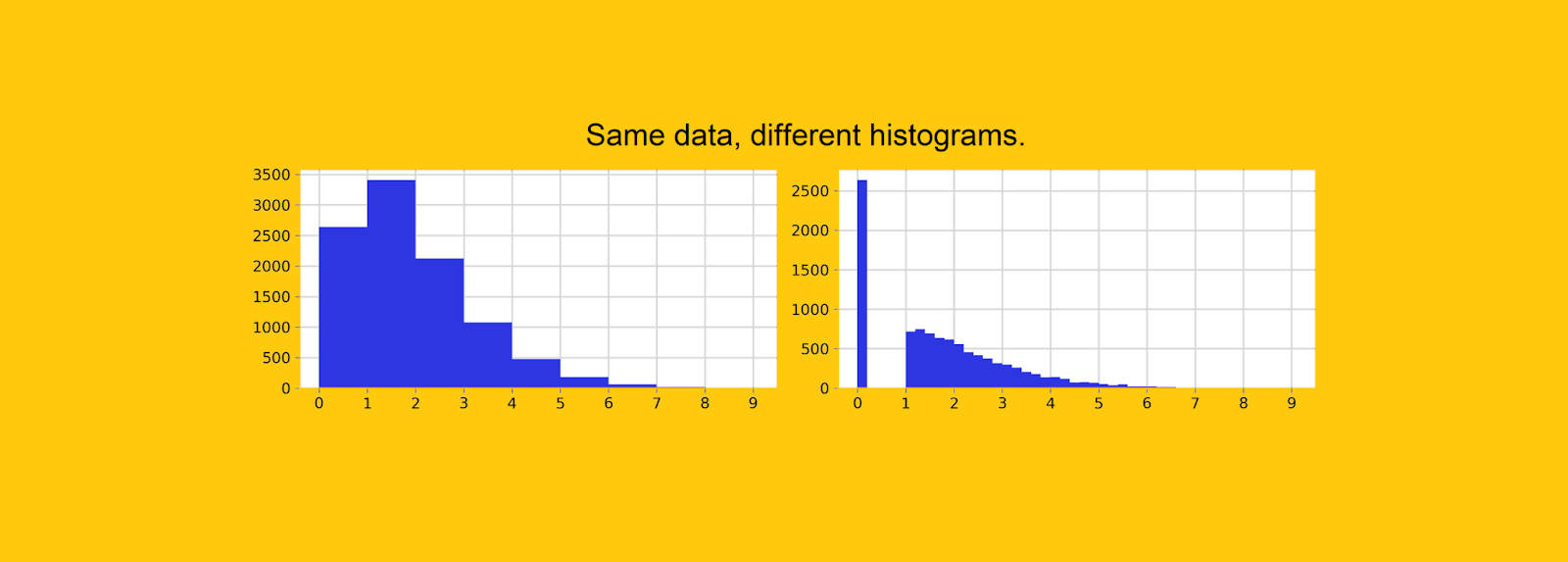
Systematic errors are not alien to histograms. The fact is that they are rather arbitrary and can lead to incorrect conclusions about the data. If you want to visualize the variable, it is better to choose a different graph.

Whether you're in a meeting with senior management or data scientists, one thing you can be sure of is that a bar chart will appear at some point.
. : . , , ? .
— !
6 , , , :
.
.
.
.
.
, .
«, : . ?» !
, CDP, .
, ?
1. .
![How the histogram changes when the number of bins changes. [Author's drawing] How the histogram changes when the number of bins changes. [Author's drawing]](https://habrastorage.org/getpro/habr/upload_files/7f1/71f/f40/7f171ff405334ac351d813ecfe7ca455.png)
( Python R), (). , . .
2. .
, , . , , . , .
, , .
![How the histogram changes when the maximum value changes. [Author's drawing] How the histogram changes when the maximum value changes. [Author's drawing]](https://habrastorage.org/getpro/habr/upload_files/29c/73d/22f/29c73d22f14a324968ab201e3bea41cc.png)
, . , : !
3. .
, , . , , «» .
, 0. , 10 , 26% — .
![Same data, different bin width. It is impossible to find a high concentration of zeros in the left graph. [Author's drawing] Same data, different bin width. It is impossible to find a high concentration of zeros in the left graph. [Author's drawing]](https://habrastorage.org/getpro/habr/upload_files/568/6cc/b23/5686ccb23bbd5f013cc5f50f419bb43b.png)
— , Python. , , , «» .
. , , , 0 - .
4. .
, . .
«» (Age). = 49 ( ) = 49,828884325804246 ( , 365,25). — , — .
![On the left is a continuous variable. On the right is a discrete variable. However, they look the same in the top plots. [Author's drawing] On the left is a continuous variable. On the right is a discrete variable. However, they look the same in the top plots. [Author's drawing]](https://habrastorage.org/getpro/habr/upload_files/9b4/66d/054/9b466d0547e9bbd529cab99fd58aba6f.png)
, , , , , . ( Python) : .
5. .
. , UCI , , :
( )
50
50
60
60 .
:
![Comparison of histograms. [Author's drawing] Comparison of histograms. [Author's drawing]](https://habrastorage.org/getpro/habr/upload_files/460/df1/ed4/460df1ed42f1a890f7b732953586512b.png)
, , , , .
6. , .
Excel, R Python, : Excel , R — hist(x), Python — plt.hist().
, . , , ? , , , , . :
| INTERVAL_LEFT | INTERVAL_RIGHT | COUNT |
|---------------|----------------|---------------|
| 75.0 | 87.0 | 31 |
| 87.0 | 99.0 | 52 |
| 99.0 | 111.0 | 76 |
| ... | ... | ... |
SQL- , . , Google Big Query :
WITH
STATS AS (
SELECT
COUNT(*) AS N,
APPROX_QUANTILES(VARIABLE_NAME, 4) AS QUARTILES
FROM
TABLE_NAME
),
BIN_WIDTH AS (
SELECT
-- freedman-diaconis formula for calculating the bin width
(QUARTILES[OFFSET(4)] — QUARTILES[OFFSET(0)]) / ROUND((QUARTILES[OFFSET(4)] — QUARTILES[OFFSET(0)]) / (2 * (QUARTILES[OFFSET(3)] — QUARTILES[OFFSET(1)]) / POW(N, 1/3)) + .5) AS FD
FROM
STATS
),
HIST AS (
SELECT
FLOOR((TABLE_NAME.VARIABLE_NAME — STATS.QUARTILES[OFFSET(0)]) / BIN_WIDTH.FD) AS INTERVAL_ID,
COUNT(*) AS COUNT
FROM
TABLE_NAME,
STATS,
BIN_WIDTH
GROUP BY
1
)
SELECT
STATS.QUARTILES[OFFSET(0)] + BIN_WIDTH.FD * HIST.INTERVAL_ID AS INTERVAL_LEFT,
STATS.QUARTILES[OFFSET(0)] + BIN_WIDTH.FD * (HIST.INTERVAL_ID + 1) AS INTERVAL_RIGHT,
HIST.COUNT
FROM
HIST,
STATS,
BIN_WIDTH
, ?
: .
6 , , : « ?» : , « » (Cumulative Distribution Plot - CDP). , , , .
— . , CDP :
x: ( );
y: .
— .
![Graph of the cumulative distribution of the maximum heart rate. [Author's drawing] Graph of the cumulative distribution of the maximum heart rate. [Author's drawing]](https://habrastorage.org/getpro/habr/upload_files/5be/acf/f95/5beacff9594412dff001cd02e1ea2e82.png)
x = 140 y = 90 (30%). : 140 . , 140 ( 90 , 30% ). , 30% 140 .
, , « » ? «»? . , ( , ). , CDP , , .
CDP . , , « 140 160?» « 180?». CDP, . .
CDP , . , :
1. . , CDP.
2. . CDP, .
3. . - , , , .
4. . (.. ), , .
5. . , , . , y 0 100%, . , , :
![Comparison of distributions in CDP. [Author's drawing] Comparison of distributions in CDP. [Author's drawing]](https://habrastorage.org/getpro/habr/upload_files/c14/de3/22d/c14de322da1e53ae4455357e8da017b5.png)
6. , . , , , SQL:
SELECT
COUNT(*) AS N,
APPROX_QUANTILES(VARIABLE_NAME, 100) AS PERCENTILES
FROM
TABLE_NAME
Excel, R, Python
Excel . 101 , 0 1. , : =PERCENTILE(DATA, FRAC), DATA - , , FRAC - : 0,00, 0,01, 0,02, 0,03,…, 0,98, 0,99, 1. , x.
R :
plot(ecdf(data))
Python:
from statsmodels.distributions.empirical_distribution import ECDF import matplotlib.pyplot as plt ecdf = ECDF(data) plt.plot(ecdf.x, ecdf.y)
! , .
. , Linkedin.
- "Machine Learning. Basic". , .
- - " "